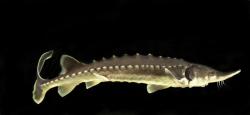Biologists Net ‘Ripe’ Sturgeon Pair on Nanticoke Tributary
By Karl Blankenship
from The Fishing Wire
When a crew of biologists from the Maryland Department of Natural Resources hauled a gill net out of the Marshyhope Creek in late August, what they hauled in was more than the catch of the day: It may have been the catch of their careers.
One of the nets contained two “ripe” – ready to spawn – Atlantic sturgeon. One was a 7-foot 3-inch, 154-pound female. The other was a 5-foot 2-inch, 70-pound male. The female was filled with black eggs, and the male was leaking sperm.
“That was probably the most exciting and rewarding day in my career,” said Chuck Stence, head of the anadromous fish restoration unit of the DNR Fisheries Service, who was leading the survey crew. “We’re out there fishing – you’re not expecting to catch anything – and then all of sudden two fish like that get dropped into your lap.”
The recent catch ended more than two years of frustration for the biologists. Fishermen have reported seeing sturgeon jumping in the Marshyhope for several years. Last fall, one landed in the boat of two anglers.
But crews from the DNR and the U.S. Fish and Wildlife Service had – until Aug. 28 – failed to net any sturgeon. The previous week, in fact, Stence and his crew saw one jump only about 40 feet from their boat, but they were unable to net it.
“It’s so frustrating when you see them jumping right in front of the boat, and you still can’t catch them,” he said.
That frustration ended as they were pulling in the last of four 100-yard gill nets that had been deployed on the 28th.
“We got maybe a third of the way through the net, and all of a sudden the net started pulling back,” Stence said. “And the closer we got, you could see the big shadow in the water. It’s amazing how the adrenaline kicks in when you go out there for three years and catch nothing, and all of a sudden you can see a big one in the net – and then having another one right behind it.”
Atlantic sturgeon are the largest fish native to the Bay, where they historically reached lengths of up to 14 feet. Once common, they suffered from overfishing, habitat destruction and pollution, resulting is a dramatic population drop in the last century. Two years ago, the National Marine Fisheries Service listed them as an endangered species.
Like other anadromous fish, sturgeon live most of their lives in the ocean, but return to their native rivers to spawn. The James River is the only Bay tributary known to still have a spawning population.
But the catch by DNR biologists could change that. “I can’t imagine a fish that big going up in there for any other reason other than to spawn,” Stence said.
Still, he added, catching the fish is “just the first little piece of the puzzle.”
Actual proof of spawning would require finding recently spawned “young of year” fish in the river. Right now, Stence said, no surveys exist in the vicinity of the Marshyhope that would catch young of year sturgeon. Now, with evidence that suggests potential spawning activity, the fishery service will consider starting one, he said.
It’s also unknown where the sturgeon came from. They could be remnants of a native Maryland population that has gone undetected for decades. It is possible, some have suggested, that they are James River fish that have wandered up the Bay. Another possibility is that they stem from a small batch of juvenile Hudson River fish that were released in the Nanticoke in 1996.
Those questions could be answered in coming weeks. The biologists took DNA samples of both sturgeon for analysis.
Biologists would like to know what habitats the fish are using. So the captured sturgeon were briefly anesthetized and the biologists made minor incisions to insert a small transmitter and a tag so they can monitor the strugeons’ movements and identify them in the future.
After that procedure, the biologists jumped into the chest-deep water and cradled the fish, “like babies,” Stence said. After about 10 minutes, the sturgeon recovered and swam away.
But Stence said, the biologists are optimistic that they have not seen the last of sturgeon on the Marshyhope.
“We’re definitely optimistic that we will see some more up there,” he said. “I’m anxious to get back out there and see if there are any more out there. At least we know where to go now.”
Indeed. Last Friday, they caught another 97-pound male.
About Karl Blankenship
Karl Blankenship is editor of the Bay Journal and Executive Director of Chesapeake Media Service. He has served as editor of the Bay Journal since its inception in 1991.

It’s great news to hear the sturgeon were mating and reproducing. I used to work at a company that manufactures those tracking transmitters they implanted. Pretty cool how technology can assist these biologists in gathering data for their studies. These prehistoric giants are certainly something to behold and I hope their species survive. Here’s a big 12′ 1100 pound sturgeon I ran across on the web you may be interested in seeing.
I agree it is great they are working to bring them back. Puts the bass I catch to shame for size!